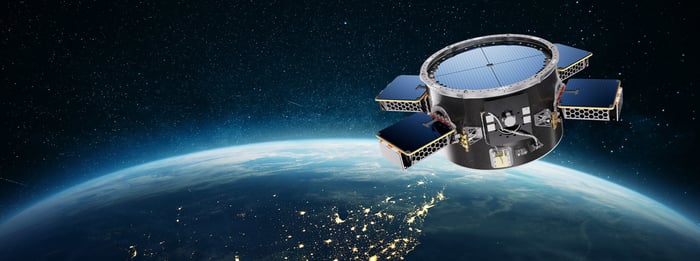Firefly Aerospace is a very interesting space stock (or to be more precise, it will be an interesting space stock if it ever gets around to IPO'ing). One of the first batch of space start-ups to arise in the early 20-teens, Firefly's predecessor company went bankrupt in 2018, according to data from S&P Global Market Intelligence, only to have its assets bought, get incorporated into another space company, and then complete the circle by buying assets from an entirely different defunct space stock (Virgin Orbit) earlier this year!
Today, Firefly Aerospace is reborn as a $1 billion-plus space company with an increasingly bright future.
Talking over Firefly and its prospects with CEO Bill Weber back in June, we learned that, in addition to the three space rockets that Firefly is developing (two of them in partnership with Northrop Grumman (NOC 0.15%)), and in addition to the Blue Ghost lander that Firefly will send to the moon mid-next year, Firefly also hopes to become a major player in the brand new industry of in-orbit satellite servicing and repair -- and in space tugs.

Image source: Firefly Aerospace.
Out of one, many
In contrast to the U.S. motto "E pluribus unum," Firefly's in-orbit satellite servicing is evolving in the opposite direction. When we spoke back in June, Firefly had just announced its acquisition of private space rideshare Spaceflight Inc., along with technology for the latter's "Sherpa" space tug. Of course, Firefly already had a space tug project of its own underway, a "Space Utility Vehicle" or SUV, designed to assist other companies' satellites by shifting them around between orbits. But by bringing Spaceflight in-house, Firefly would have two separate space tug models to offer its customers.
Yet it seems even two tugs aren't enough for Firefly. Now it wants three.
Last week, Firefly announced it is incorporating Sherpa's technology into the "SUV," renaming the space tug the more lyrical "Elytra," and planning to offer it in three different models: Dawn, Dusk, and Dark.
All three Elytra models will offer "on-orbit mobility, hosting, delivery, and servicing" in the space between Earth and the moon -- activities encompassing everything from moving other satellites around, to giving them a nudge out of orbit to burn up in the atmosphere when they break down, to (potentially) refueling and repairing defunct satellites. "Dawn" Elytras will operate primarily in Low Earth Orbit or LEO. "Dusk" Elytras can operate either in LEO or at geosynchronous (GEO) ranges (i.e. much farther out). "Dark" Elytras will specialize in boosting spacecraft from LEO into trajectories ending at the moon or beyond.
And all three Elytra models will be "scalable and customizable to support each customer's unique on-orbit needs," says Firefly VP of Spacecraft Jana Spruce.
Elytras and Photons and MEVs (oh my!)
Firefly joins a field of space tug service providers that was already getting crowded. Tiny Momentus was one of the first to express interest in building a space tug empire, but with little revenue, no profits, and a rapidly dwindling cash stockpile, Momentus is probably already on its way out.
Quick to spot an opportunity, Rocket Lab (RKLB -0.10%), already the leader in small rocketships for launching satellites, developed a space tug of its own, the Photon. Similar to an Elytra Dawn, Photon has served as a "kick stage" to put some satellites in their proper orbits around Earth. Like an Elytra Dark, it has also "kicked" one satellite all the way to the moon. And in 2025, Photon will attempt to propel a small spacecraft all the way to Venus.
Defense contracting giant Northrop Grumman -- Firefly's partner in rocketship building -- is meanwhile the leader in more advanced space tugs. At least two Northrop Mission Extension Vehicles (MEV) are in orbit already, extending the service life of satellites for its customer Intelsat. And Northrop's already moving on to a second-generation space tug, the "Mission Robotic Vehicle" or MRV. This one will extend the MEV concept by creating a mothership vehicle carrying multiple "pods," each of which can function as a separate MEV to tug rogue satellites hither and thither in orbit.
(So you can kind of think of MRV as a "MEV that MIRVs".)
What it means to investors
Long story short, Firefly is coming to this race a little late -- but that's OK. Space is big, and the opportunities for growth in the space tug market seem substantial. According to one source, at the end of 2021 there were approximately 4,550 satellites in orbit, a number that grew to more than 6,700 through the start of this year.
Most of these satellites -- 72% -- are tiny satellites, too small and too disposable to be worth repairing them when they break down or changing their orbits when they wander off course. Furthermore, 84% of these tiny satellites are in LEO and will fall back to Earth and burn up in the atmosphere within a reasonable amount of time, such that it's probably not worth hiring a space tug to nudge them down even if they break down.
That still leaves roughly 1,000 satellites cruising along in Medium Earth Orbit or Geosynchronous Earth Orbit, however. Big, expensive satellites that are far too far away to dispose of themselves, and that may be worth the time and money to send a space tug to tend to from time to time.
How much money? Well, details in this nascent market are in flux. But Northrop reportedly got $65 million for its first MEV mission. Multiplied by 1,000 satellites that might potentially, eventually need fixin', that works out to -- well, about $65 billion in total market opportunity.
And this market is only getting bigger.
Seems to me Firefly has lit upon an attractive target, and a lucrative business model that offers a good chance of growth in the future. The only thing that would make this opportunity more attractive would be if Firefly would IPO so that we can invest in it.




